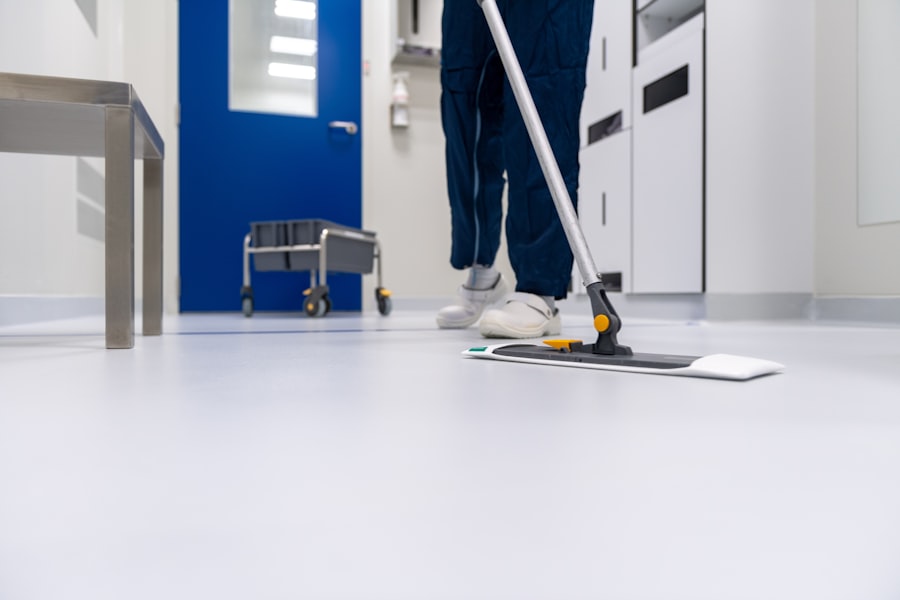
- By: admin
- Category: Commercial Floor Cleaning Machines
- 0 comment
In the realm of commercial cleaning, scrubbers play a pivotal role in maintaining hygiene and cleanliness, particularly in food service areas. There are several types of scrubbers available, each designed to tackle specific cleaning challenges. The most common types include walk-behind scrubbers, ride-on scrubbers, and automatic scrubbers.
Walk-behind scrubbers are ideal for smaller spaces, allowing operators to manually control the machine while effectively cleaning floors. These machines are versatile and can be used in various settings, from kitchens to dining areas. On the other hand, ride-on scrubbers are designed for larger spaces, enabling operators to cover more ground in less time.
These machines are particularly beneficial in expansive food service areas, such as large commercial kitchens or dining halls, where efficiency is paramount. Automatic scrubbers, which can be either walk-behind or ride-on, offer advanced features such as automated cleaning paths and programmable settings. Understanding the differences between these types of scrubbers is crucial for facility managers and contract cleaners, as it allows them to select the most suitable equipment for their specific needs.
Summary
- There are different types of scrubbers, including walk-behind, ride-on, and handheld models, each with its own advantages and applications.
- When choosing a scrubber for your food service area, consider factors such as the size of the area, the type of flooring, and the level of foot traffic.
- Before scrubbing, it’s important to prepare the area by removing obstacles, sweeping or vacuuming, and marking off any hazardous areas.
- Using the correct cleaning solution is crucial for achieving the best results and avoiding damage to the flooring or the scrubber itself.
- Proper technique for using a scrubber includes starting from the furthest point and working towards the exit, overlapping each pass for thorough cleaning.
Choosing the Right Scrubber for Your Food Service Area
Selecting the appropriate scrubber for your food service area involves considering several factors, including the size of the space, the type of flooring, and the nature of the messes typically encountered. For instance, if you manage a bustling restaurant with a large kitchen and dining area, a ride-on scrubber may be the best choice due to its efficiency and speed. Conversely, if your establishment has tighter spaces or requires more detailed cleaning, a walk-behind scrubber might be more effective.
Additionally, it’s essential to consider the type of flooring in your food service area. Different surfaces may require specific types of brushes or pads to avoid damage while ensuring a thorough clean.
By carefully evaluating these factors, facility managers can make informed decisions that enhance cleanliness and operational efficiency.
Preparing the Area for Scrubbing

Before deploying a scrubber in any food service area, proper preparation is key to achieving optimal results.
This not only ensures a more efficient clean but also helps prevent potential damage to both the scrubber and surrounding items.
It’s also advisable to conduct a quick inspection of the floor for any significant spills or hazards that need immediate attention. Once the area is clear, it’s important to assess the condition of the floor. If there are any visible stains or sticky residues, pre-treating these areas with an appropriate cleaning solution can enhance the effectiveness of the scrubbing process.
This step is particularly crucial in food service environments where hygiene is paramount. By taking the time to prepare the area adequately, you set the stage for a successful scrubbing session that leaves your space sparkling clean.
Using the Correct Cleaning Solution
The choice of cleaning solution is integral to achieving effective results when using a scrubber in food service areas. Not all cleaning solutions are created equal; some may be too harsh for certain surfaces or ineffective against specific types of grime. It’s essential to select a cleaning solution that is not only effective but also safe for use in food preparation environments.
Look for products that are specifically formulated for commercial kitchens and comply with health and safety regulations. Moreover, understanding the dilution ratios and application methods for your chosen cleaning solution is vital. Some solutions may require dilution with water before use, while others can be applied directly.
Following manufacturer guidelines ensures that you achieve the best results without compromising safety or damaging surfaces. By using the correct cleaning solution tailored to your specific needs, you can enhance the scrubbing process and maintain a hygienic environment.
Proper Technique for Using a Scrubber
Utilising a scrubber effectively requires more than just turning it on and letting it do its job; proper technique plays a significant role in achieving optimal results. Begin by familiarising yourself with the machine’s controls and settings before starting. Adjusting the speed and pressure settings according to the type of flooring and level of soiling can make a substantial difference in cleaning efficiency.
When operating the scrubber, it’s important to maintain a steady pace and overlap your passes to ensure complete coverage of the area. This technique helps prevent missed spots and ensures that all surfaces receive adequate attention. Additionally, pay attention to corners and edges where dirt tends to accumulate; using a hand-held scrubber or brush in these areas can complement your efforts and enhance overall cleanliness.
Paying Attention to Problem Areas

In any food service environment, certain areas are more prone to dirt and grime accumulation than others. High-traffic zones, such as entryways and near cooking stations, often require extra attention during scrubbing sessions. Identifying these problem areas allows facility managers and contract cleaners to allocate resources effectively and ensure that no spot is overlooked.
Regularly inspecting these high-risk areas can also help in developing a targeted cleaning strategy. For instance, if you notice that grease tends to build up around fryers or grills, consider implementing more frequent scrubbing sessions in those locations or using specialised cleaning solutions designed to tackle grease effectively. By being proactive about problem areas, you can maintain a consistently clean environment that meets health standards.
Maintaining the Scrubber for Longevity
To ensure that your scrubber remains effective over time, regular maintenance is essential. This includes routine checks on brushes, pads, and squeegees to ensure they are in good condition and functioning properly. Worn-out brushes can lead to ineffective cleaning and may even damage floors if not replaced promptly.
Additionally, keeping the scrubber clean itself is crucial for its longevity. After each use, emptying the recovery tank and rinsing it out prevents residue build-up that could lead to odours or bacterial growth. Regularly inspecting hoses and connections for leaks or blockages also contributes to optimal performance.
By investing time in maintenance, you can extend the life of your scrubber and ensure it continues to deliver excellent results.
Avoiding Common Mistakes When Using a Scrubber
Even experienced users can fall prey to common mistakes when operating a scrubber in food service areas. One frequent error is neglecting to adjust settings based on floor type or soil level; using too much pressure on delicate surfaces can cause damage while insufficient pressure may fail to remove stubborn stains. Always take a moment to assess your environment before starting.
Another common mistake is failing to follow proper cleaning protocols, such as not pre-treating heavily soiled areas or skipping necessary steps in preparation. These oversights can lead to subpar results and may even compromise hygiene standards in food service environments. By being mindful of these common pitfalls and adhering to best practices, you can maximise the effectiveness of your scrubbing efforts.
Ensuring Safety When Using a Scrubber
Safety should always be a top priority when using scrubbers in commercial settings. Operators must be trained on how to use the equipment safely and effectively while adhering to all relevant health and safety regulations. This includes wearing appropriate personal protective equipment (PPE), such as gloves and non-slip footwear, to minimise risks during operation.
Furthermore, it’s essential to ensure that all safety features on the scrubber are functioning correctly before use. This includes emergency stop buttons and proper signage indicating wet floors after scrubbing. By fostering a culture of safety within your team and ensuring everyone is aware of best practices, you can create a safer working environment while maintaining high standards of cleanliness.
Finding the Right Balance Between Frequency and Intensity of Scrubbing
Determining how often and how intensely to scrub your food service area requires careful consideration of several factors, including foot traffic levels, types of food prepared, and specific hygiene requirements. High-traffic areas may necessitate more frequent scrubbing sessions compared to less frequented spaces; however, over-scrubbing can lead to unnecessary wear on flooring materials. Striking the right balance involves assessing both frequency and intensity based on observed conditions within your facility.
For instance, if you notice that certain areas accumulate dirt quickly due to heavy use or spills from food preparation activities, increasing both frequency and intensity in those zones may be warranted. Conversely, less frequented areas might only require periodic maintenance scrubbing sessions.
Seeking Professional Help When Necessary
While many facility managers and contract cleaners are well-equipped to handle routine scrubbing tasks, there are times when seeking professional assistance becomes necessary. If you encounter particularly stubborn stains or extensive damage that exceeds your team’s capabilities, enlisting professional cleaners can provide specialised expertise and advanced equipment that ensures thorough cleaning. Additionally, professional services can offer valuable insights into best practices for maintaining cleanliness in food service environments based on their experience across various industries.
By recognising when it’s time to call in experts, you can ensure that your facility remains compliant with health regulations while providing a safe and hygienic environment for both staff and customers alike. In conclusion, understanding how to effectively utilise scrubbers in food service areas is essential for maintaining cleanliness and hygiene standards within commercial settings. By selecting the right equipment, preparing adequately before scrubbing sessions, using appropriate cleaning solutions, employing proper techniques, paying attention to problem areas, maintaining equipment regularly, avoiding common mistakes, ensuring safety protocols are followed diligently, finding an optimal balance between frequency/intensity of scrubbing tasks—and knowing when professional help is needed—you can create an environment that promotes healthiness while enhancing operational efficiency within your establishment.
FAQs
What is a scrubber in food service areas?
A scrubber in food service areas is a cleaning tool used to remove dirt, grime, and grease from floors, walls, and other surfaces. It typically consists of a motorized machine with a rotating brush or pad that agitates and lifts dirt from the surface, along with a water and detergent solution to help with the cleaning process.
How do you use a scrubber in food service areas?
To use a scrubber in food service areas, first, ensure the area is clear of any obstacles and debris. Then, fill the scrubber’s solution tank with the appropriate cleaning solution and water. Next, turn on the machine and slowly guide it across the surface, allowing the brush or pad to agitate and lift the dirt. Finally, use a squeegee attachment to remove any excess water and allow the surface to dry.
What are the benefits of using a scrubber in food service areas?
Using a scrubber in food service areas offers several benefits, including more efficient and thorough cleaning, reduced physical strain on cleaning staff, improved hygiene and sanitation, and a more professional and presentable appearance for the establishment.
What safety precautions should be taken when using a scrubber in food service areas?
When using a scrubber in food service areas, it is important to follow safety precautions such as wearing appropriate personal protective equipment (PPE) including non-slip footwear, gloves, and eye protection. Additionally, ensure that the area is well-ventilated and that any electrical cords are safely secured to prevent tripping hazards. Regular maintenance and inspection of the scrubber machine are also essential to prevent accidents and ensure safe operation.
